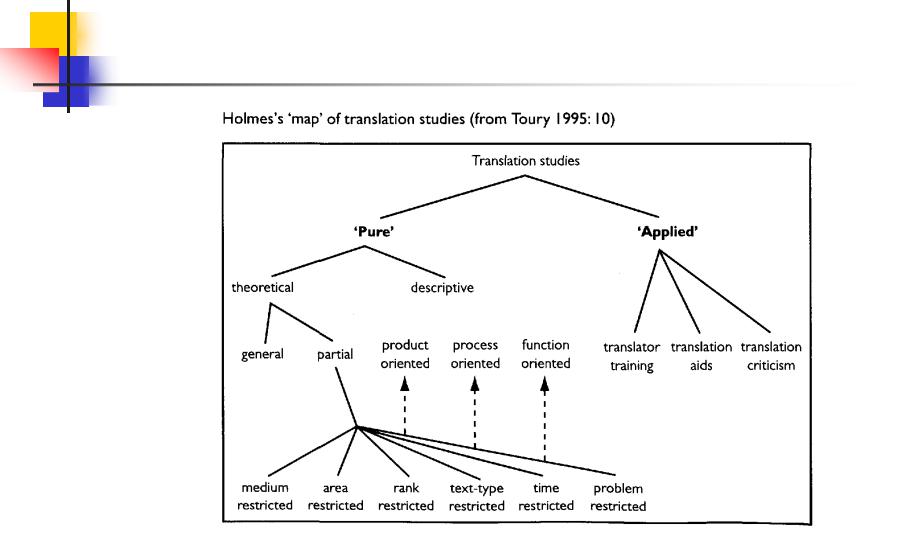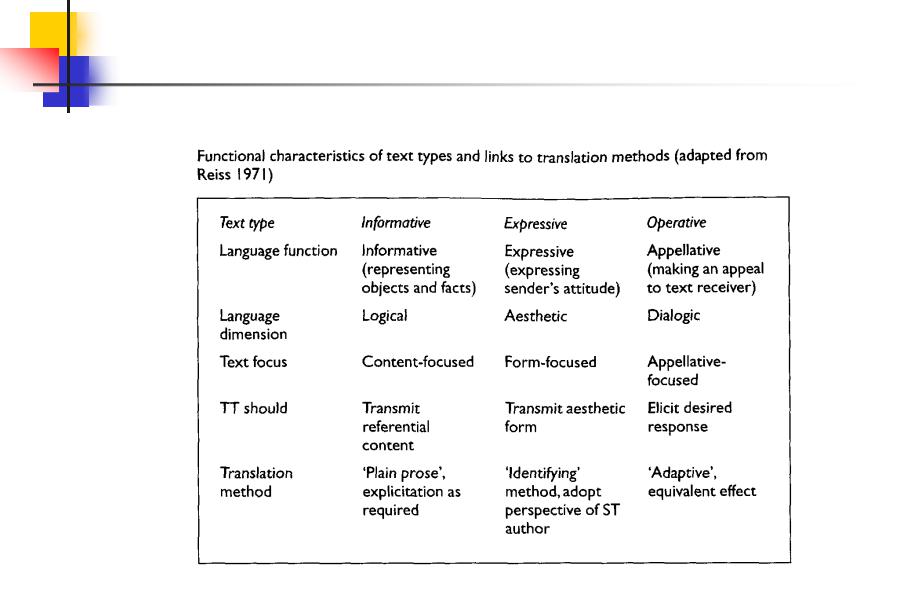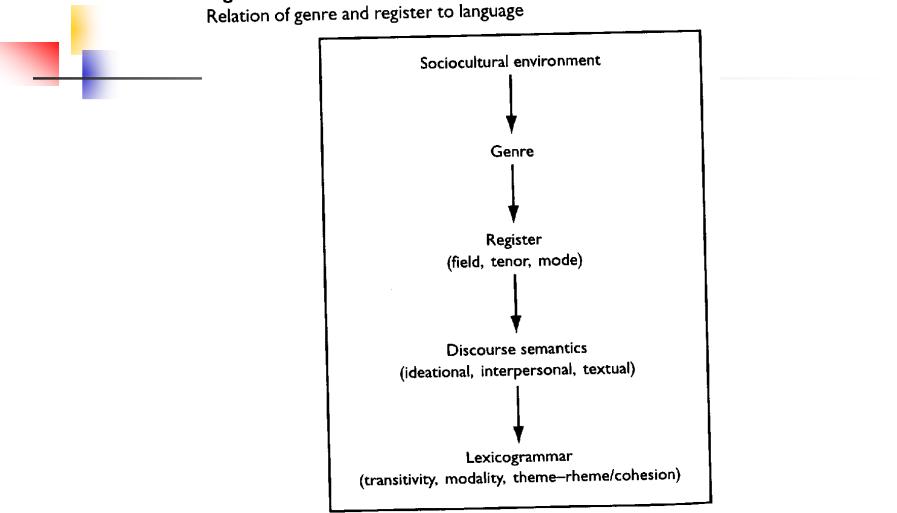
Общая теория / Modern TS Theories
.pdf
Modern TS Theories
§1. Approaches within Linguistic Framework §2. Communicative/Functional Approaches §3. Discourse and Register Analysis
§4. (Literary) Systems Theories §5. Cultural Studies
§6. Cognitive Approaches
§7. Applied Translation Studies

References
Munday, Jeremy. Introducing translation studies. – London: Routledge, 2001.
Pérez, María Calzada. Applying Translation Theory in Teaching http://www.iatis.org/newvoices/issues/2005/calzada-NV2005.pdf
Routledge encyclopedia of translation studies / edited by Mona Baker.
– London: Routledge, 1998.
Nord, Christiane. Text Analysis in Translation, 1988.
Pym, Anthony. Redefining Translation Competence in an Electronic Age. In Defence of a Minimalist Approach, 2003. http://www.erudit.org/revue/META/2003/v48/n4/008533ar.html
Алексеева, Л.М. Перевод как рефлексия деятельности // Вестник пермского университета, Вып. 1(7). – Пермь, 2010. – С. 45-51.
Галеева, Н.Л. Перевод в культуре: уточнение статуса и понятий // Критика и семиотика. Вып. 9. – Тверь, 2006. - С. 24-35.

Holmes, James. S. The Name and Nature in Translation Studies, 1988 – the founding statement for the field

§1. Approaches within Linguistic TS
A focus on (mostly ‘discrete’ units of) languages:
Roman Jacobson 1959 “Equivalence in difference is the cardinal problem of language and the pivotal concern of linguistics” (cheese/syr), “Languages differ essentially in what they must convey, not in what they may convey”.
Equivalence and equivalent effects (Eu.Nida, W.Koller,
P.Newmark)
The translation shift approach/studies of taxonomies of linguistic changes which occur in translation (Catford, Vinay and Darbelnet 1977)
Comparative-descriptive model of van Leuven-Zwart
Czeck linguists: Popovic, Levy

 §2. Communicative/Functional Approaches:
§2. Communicative/Functional Approaches:
A focus on the communicative nature of texts (text-types and their functions in TargetCulture):
2.1.Text-types of K.Reiss 1971
2.2.Skopos-theory (Vermeer 1978)
2.3.Translation action model (Holz-Mantarri 1984)
2.4.Translation-oriented text analysis (Christiane Nord 1991).

2.1. K.Reiss 1971: beyond considerations of lower linguistic
levels towards a consideration of the communicative purpose!
Different source-text types pose different challenges to translators.
See function-oriented distribution of text-varieties

2.2. Skopos-theory
Reiss and Vermeer 1984
A translation is a secondary offer of information, imitating a primary offer of information; it is a culture-transcending process; the theory “dethrones” ST.
It is not the source text as such, or its effects on the source-text recipient, or the function assigned to it by the author, that determines the translation process, but the prospective function or skopos of the target text as determined by the initiator's, i.e. client's, needs, his commission + the culture of the intended readers of the TT (scientific and academic papers, instructions for use, tourist guides, contracts, etc.)
The coherence rule stipulates that the target text must be sufficiently coherent to allow the intended users to comprehend it, given their assumed background knowledge and situational circum-stances.
The fidelity rule concerns intertextual coherence between translatum and source text, and stipulates merely that some relationship must remain between the two once the overriding principle of skopos and the rule of (intratextual) coherence have been satisfied.
Criticism:
there should be a limit to what may legitimately be called translation as opposed to adaptation.
the emphasis on the message at the expense of richness of meaning and to the detriment of the authority of the source-language text.
less applicable to literary translation: skopos theory appears to see the text only as realization, and not as a potential which can be used in different situations with different addressees and having different functions.

2.3. Translation action model
Holz-Mantarri,1984
Translation as a communicative process. It places non-literary commercial translations into sociocultural context.
Description of its participants, roles and their goals (the initiator, the commissioner, the ST producer, the TT producer, the TT user, the TT receiver).
“It is not about translating words, sentences or texts but about guiding the intended co-operation over cultural barriers enabling functionally oriented communication”.
It focuses on the TT production that is functionally suitable for the TT receiver; the form and genre of the TT is determined by suitability in Target Culture, rather than the original features of the ST.
Criticism: complicated jargon, disregard of the ST, translator’s “absolute license”

2.4. Translation-oriented text analysis
Christiane Nord 1991
Describes a model of ST analysis helping to understand the functions of ST features and to select translation strategies appropriate to the intended purposes of the TT.
Highlights three aspects of functionalist approach important in translator’s training :
1)Translation commission (comparison of ST-TT profiles – is any divergence between ST and TT required by the commission in terms of the addressees, the motive, the medium)?
2)The role of ST analysis (analysis of ST intralingual features, such as subjectmatter, connotations, presuppositions, lexic, composition, to decide which of them should be prioritized in translation)
3)Functional hierarchy of translation problems (decision-making on type of translation (below), functional elements to be adapted to TC, SCor ЕС-oriented translation style, microlevel decisions)
Two basic types of translation product and process:
Documentary translation is a document (copy) of SC communication betweem the ST author and ST recipient; the TT reader is aware that it is a translation (literary and literal translations)
Instrumental translation is an independent message-transmitting instrument; the TT receiver reads TT as if it were written in his language (function-preserving instructive texts and adaptations to contemporary audiences)

|
|
|
|
§3. |
Analysis |
|
|
|
|
||
|
|
|
|
||
|
|
|
|
A focus |
texts |
|
|
|
|
||
|
|
|
|
||
|
|
|
|
Discourse |
in socio-cultural |
|
|
|
|
context |
|
|
|
|
|
Inspired |
(known as |
|
|
|
|
|
speaker’s |
|
|
|
|
the |
function of |
|
|
|
|
of speech) |
|
|
|
|
|
behind |
|
|
|
|
|
The |
text |
|
|
|
|
|
text “means”. |
|
|
|
|
Ex.active |
signals |
3.1. |
Juliane |
||||
|
|
|
|
House |
|
3.2.Text and pragmatic level analysis by Mona Baker 1992
3.3.The semiotic level of context and discourse by Hatim and Mason
